Re–Positioning Public Libraries in Nigeria for Social Inclusion Services
Victor Esheruma Igiamoh and Olubunmi Adesola Ogunwemimo
Abstract
This study investigates services provided by public libraries in Nigeria to promote social inclusion in their communities. The research method adopted for the study was a social survey and the research instrument used was a questionnaire. The study revealed a lack of specific budgeting and training, and few services geared towards social inclusion in public libraries. Related services such as employment information and generation; information for farmers, the elderly, and artisans; literacy; and creative writing sessions, among others, are not being regularly provided in the libraries. The study recommends the education and training of public librarians on social inclusion services, adequate provision of government information to libraries and librarians, the involvement of public librarians in community development programmes, and the sharing of demographic and development information with public libraries and librarians by government and private organizations, among others.
1. Introduction
In this era of abundant information production and utilization, “information for all” is a slogan common to every nation. The public library is an important agent for achieving this goal. The public library provides educational, social, and political services and information to people in a particular community. It serves the community, and, as a result, is referred to as the “layman’s university” (Saliu, n.d.). It is a service–oriented institution usually owned or funded by governments, responsible for fulfilling the information needs of the community. Public libraries should address all primary information needs and access to information; they should not be superficially “open to all” (Fourie, 2007). The public library has a crucial role in engaging all excluded groups into the community, as it has the advantage of being local and having a vast number of users.
It thus has frequent and direct contact with the community; no other public institution is better positioned as public library to cultivate a social environment (Man, 2007). However, though the important roles of public libraries have been stressed in literature, no practical steps have been taken to harness its potential in national development, particularly in developing countries. Public libraries are faced with numerous challenges that have interfered with their ability to perform their primary functions for their communities. The potential of the library needs to be harnessed by government to better the lot of society.
In order to improve information services in Africa, the United Nations Economic Commission for Africa (ECA) recommended a system of public libraries and resource centers, supporting communities of all sizes, and recognized them as a vital component of the national strategic information management framework (Amonoo and Azubuike, 2005). It is very important to recognize the library as a vital organ for national development. This will go a long way in promoting a socially inclusive society.
Social inclusion, according to Fourie (2007) can be defined via an understanding of social exclusion. Social exclusion occurs when people or places suffer unemployment, discrimination, lack of skills, inadequate housing, poor health conditions, etc. It is common knowledge that the elements of social exclusion as identified are a major occurrence in Nigeria. Government and private organisations have made efforts to eradicate these problems, but how often do they recognize public libraries as a key factor in solving them? Over the years, public libraries have not been included in the implementation of programmes and policies aimed at meeting the needs of the people. This may be borne out of underestimating the potential of public libraries’ information provision services to meet the needs of the people.
Sheba (1998), in her study on information and development in Africa, concluded that one of the main problems related to information provision in Africa has been a failure to acknowledge the interdependence of information and development. Government and other organizations pay lip service to public libraries, due to their ignorance of the capability of information services to transform the nation. The community focus of the public library makes it a potent agent for social inclusion: it has adequate knowledge of the people in the community and their information needs. Therefore, it is in a better position to address the information needs of the socially excluded people in the community.
1.1 Statement of the Problem
The economic, social, educational, and political challenges of Nigeria have continued to increase the frequency of social exclusion. The unemployment rate in the country is high; the gap between the rich and the poor is getting wider; illiteracy is prevalent, and many other social problems are on the increase. These conditions can be adequately reduced or eradicated by an efficient and effective public library system. Unfortunately, funding and other support for public libraries have continued to decline. This has negatively affected the quality of service delivery, as well as public trust and confidence in the libraries. The public libraries need to be repositioned to render effective information services to the socially excluded people in their communities despite these challenges.
Scope of the Study
The characteristics of all public libraries in Nigeria are generally the same. Therefore, this study was limited to public or community libraries in the Oyo State in the southwestern part of Nigeria. The survey covered 90% of the public and community libraries that are spread across the thirty–three Local Government Areas (LGAs) of the State.
1.2 Objectives
- To ascertain the state of the public library in promoting social inclusion in Nigeria
- To ascertain the policies and programmes, if any, of public libraries to serve the socially excluded in the community
- To investigate the challenges militating against the public libraries’ ability to promote social inclusion
- To make recommendations on methods or strategies for encouraging social inclusion services in the community
1.3 Research Questions
- What is the status of the public library in rendering social inclusion services to the people?
- Do public librarians have adequate knowledge to be able to provide social inclusion services?
- What are the social inclusion programmes of the public library, if available?
1.4 Research Method
This study was carried out using a social survey research method. The research instrument adopted for the study was a questionnaire. It was structured to assess the social inclusion services in the libraries. The research instrument was validated using expert opinion. A purposive sampling technique was used to select the librarians involved in the study. The population of the study is the heads of the various community and public libraries in each of the thirty–three LGAs of the state, as they were in a position to be able to give adequate information about the library services. Fourteen LGAs have one public/community library each, nine have three each, and four have two, for a total of fifty. Fifty questionnaires were distributed accordingly to the librarians managing each of the libraries; thirty–eight questionnaires were completed by the librarians and returned. This represents a 76% response rate.
1.5 Background to the Study
There are different categories of public libraries in the state, offering various types of services to the population: local government libraries, community libraries, and state government–managed public libraries. The Oyo State Public Library was established to fulfill the information needs of the general population of the state. Its services date back to 1955, when the then Western Regional Government, led by the late Sage, Chief Obafemi Awolowo, started the free primary education programme. The library was established to support students in formal education, and to provide reading opportunities for those seeking an informal process to further their education. However, it was not until August 1988 that library services had a facelift, with the inauguration of a board backed by an enabling law: Oyo State Library Edict No. 18 of 1988, now reviewed to Oyo State Library Law, CAP 109 No. 18 of 1988. Among the responsibilities of the board are establishing and maintaining library and documentation services within the state; providing such services as are usually provided by libraries of the highest standard; the control, maintenance and operation of all existing state and local government libraries, including those of ministries and parastatals; encouraging the establishment of libraries in the state; and making available to the various interests and institutions the widest possible range of books and other records of intellectual works in arts, science and technology.
2. Literature Review
A library is an agency which engages in the collection, processing, preservation and dissemination of recorded/electronic information in the various formats most convenient to its target users (Olanlokun and Sanusi, 1993). It can also be defined as a building established for the purpose of collecting and storing books and related materials for reading and research. Among the various types of library are public libraries, which are usually established to serve the information needs of specific population.
A public library is a library that is accessible by the public and is generally funded by public sources (such as tax revenue) and operated by civil servants. Public libraries exist in many countries around the world, and are often considered an essential part of an educated and literate population. They are distinct from research libraries, school libraries, and other special libraries, in that their mandate is to serve the general public’s information needs (rather than the needs of a particular school, institution, or research population). They also provide free services, such as pre–school story times to encourage early literacy, quiet study and work areas for students and professionals, or book clubs to encourage appreciation of literature in adults (Rubin, 2010).
Public libraries also provide materials for children (often housed in a special section), child–oriented Web sites with online educational games, Braille materials, books on tape, young adult literature and other materials for teenagers, materials in foreign languages, and computer and Internet access to patrons (IFLA, 2009).
2.1 Importance of Public Libraries
The specific importance of public libraries, as captured by Amonoo and Azubuike (2005) in ECA’s briefing paper, was to:
- Make significant contributions to formal and informal education, including lifelong learning and various forms of literacy by providing facilities, resources and services designed to ensure access to relevant information in appropriate formats, language, content and contexts;
- Ensure social inclusion and cohesion by providing access to information and knowledge to all women, men, and children. This critical access, when used by the disadvantaged — such as the poor, the elderly, the disabled, and the unemployed — forms the foundation of poverty reduction, since information poverty is often the root cause of economic poverty;
- Preserve and promote cultural heritage and diversity, and foster mutual understanding and respect among cultures and peoples;
- Create citizen awareness and engender social values for democratic governance and traditions, by opening multiple windows to the world and its alternate possibilities through their collections, facilities and programmes; and
- Harness information and knowledge for economic development through professional processing, storage and dissemination to stimulate innovation and human capacity for efficiency and productivity.
2.2 Social Inclusion/Exclusion
Social inclusion refers to a policy designed to ensure that all people are able to participate in the society regardless of their background or specific characteristics. Compared to the general population, groups with special characteristics are much more likely to face low education, unemployment, homelessness, poverty, and social exclusion. Social inclusion also refers to all efforts and policies to promote equal opportunities to people from all circumstances and from all socially excluded categories. Different forms of exclusion include political, economic, social, and cultural exclusion. However, more generally, the causes of social exclusion that lead to poverty, suffering, and sometimes death, can be attributed to the operations of unequal power relations (Bhalla and Lapeyre 1997; Justino and Litchfield 2005; Tilly 2007). It may be difficult to define social inclusion without making reference to the concept of social exclusion. Fourie (2007) stated that in defining social inclusion, it is important to understand social exclusion. According to him, “social exclusion is often linked to poverty, it happens when people or places suffer from a series of problems such as unemployment, discrimination, poor skills, poor housing, poor health conditions etc.”. Dr. Lynn Todman, Director of the Institute on Social Exclusion at the Adler School of Professional Psychology stated that social exclusion refers to processes in which individuals and entire communities of people are systematically blocked from rights, opportunities and resources (e.g., housing, employment, health care, civic engagement, democratic participation and due process) that are normally available to members of society and which are key to social integration. It is the outcome of multiple deprivations that prevent individuals or groups from participating fully in the economic, social, and political life of the society in which they live.
2.3 Public Libraries and Social Inclusion
The public library has a crucial role in engaging all excluded groups into the community because it has the advantage of being local and having a vast number of users. It has frequent and direct contact with the community. As a result, no other public service is better positioned than the public library to cultivate a social inclusion environment (Man, 2007).
For the social inclusion programme of any public library to succeed, the Council for Museums, Archives and Libraries (2000) suggested that:
- The focus on passive provision of books and materials needs to be replaced by a much more active and educative role for library staff;
- The emphasis of the library on individual service, inevitable to some degree, needs to be supplemented by a community development and community education role;
- The universalist idea of access for all needs to be given real meaning for excluded people through the development of targeting, priority resourcing and positive action programmes;
- The concept of the library needs to be broad and all embracing and not focused simply on buildings, institutions and the barriers they erect. Outreach, partnerships and joint provision all have a place in creating a new, more accessible “library” for the twenty–first century.
In order to ensure social inclusion, the needs of the target group or socially excluded must be well understood. This may include their expressed or unexpressed needs and dormant information needs (Fourie, 2007). The information needs of library users are generally accepted as crucial to the successful information services to the potential users. The information needs of the socially excluded must be well investigated and interpreted because they may be dynamic, changing with the policies and programmes of government and agencies. Dutch and Muddiman (2007) stated the highest concentration of socially excluded people lies within certain regions of the country and then, within these regions, in particular neighborhoods and excluded communities. Information services to encourage social inclusion have to be based on a clear understanding of the community.
Dutch and Muddiman (2007) in their study noted that the success recorded in the U.K. relating to the promotion of social inclusion is attributed to a community–based approach. Most of the initiatives and policies aimed at tackling information exclusion have their origin in local, not national, policy. This brings such a programme closer to the people and is more likely to be successful.
The dwindling funding of the public libraries in Nigeria is one of the numerous challenges facing the information sector. This necessitated the need for libraries to partner and collaborate to promote quality information services in the society. The public library needs proper funding to support its activities. Partnership is important for public libraries to make an appreciable impact in the life of its users. The positive impact of partnership in public libraries is evident in the grant from EIFL (Electronic Information for Libraries), an international organisation interested in public libraries. A number of their intervention programmes on public libraries are as follows:
Ghana Library Board, Tamale, Ghana
The Internet Access and Training Programme improves young people’s chances in life by linking ICT (Information and communications technology) with leadership training. The library trained 190 students from Tamale and surrounding villages, where unemployment and school dropout rates are high.Public Library “Radislav Nikcevic”, Jagodina, Serbia
Fruit, livestock and dairy farmers and beekeepers in Serbia report increased sales through the librarys online market, AgroLib — www.agrolib.rs. This project created a network of four village libraries to teach farmers ICT skills and link them with government support services. The ICT facility provides automatic weather updates, news for farmers and digitized magazines and books.Public Library “Braka Miladinovci” Radovis, Macedonia
In employment generation, in just one year, the Creative Minds Creates Jobs service has helped thirty–one people find jobs. The library’s new service builds jobseekers’ confidence and brings jobseekers and employers together through a jobs website. Of a total of sixty–seven, thirty–one (46%) have found jobs.Kenya National Library Service (KNLS)
Librarians have trained over 1,600 health workers, students and members of the public to use the e–health corners to access online health resources. Working with the Ministry of Public Health and Sanitation, the two libraries also now regularly host lectures for health workers and the general public on topics including HIV/AIDS and other sexually transmitted diseases, personal hygiene, malaria and TB.
The public librarian must be properly trained to manage the different aspects of social inclusion that may be prevalent in his/her community. This is to enable them to acquire the necessary skills and knowledge that will prepare them for the task ahead. A public librarian should have the ability to deal with people; ability to work with partners; ability to communicate with people; ability to negotiate funding and support; ability to deal with failure and frustration; ability to appreciate the impact of diversity; cognitive behavior; affective behavior and attitude (Fourie, 2007).
3. Analysis and Discussion
The total number of duly completed questionnaires was thirty–eight. This represents about a 76% response rate. The data collated was analyzed using simple percentages for easy analysis and interpretation. The analysis and presentation are as follows:
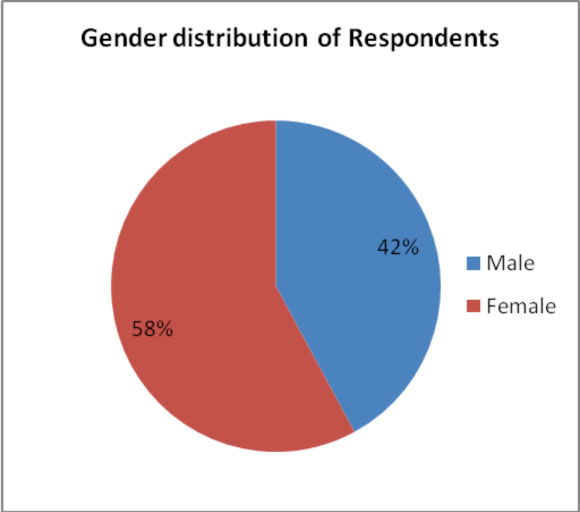 |
| Figure 1: Gender Distribution of Respondents. |
According to Figure 1, 58% of the respondents (librarians) are female while 42% are male. This represents the gender distribution of librarians in the public and community libraries involved in study.
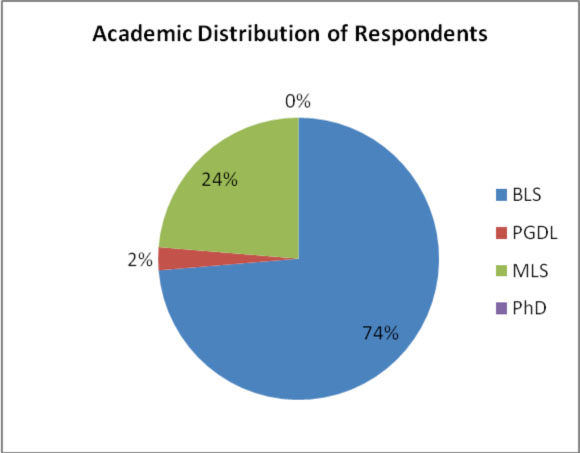 |
| Figure 2: Distribution of Respondents by Academic Qualifications. |
Figure 2 shows that the majority (74%) of the librarian respondents have a bachelors degree in library science (BLS), 24% percent have a Masters in Library Science (MLS), and 2% have a Postgraduate Diploma Degree in Library Science (PGDL), and none has a Ph.D.
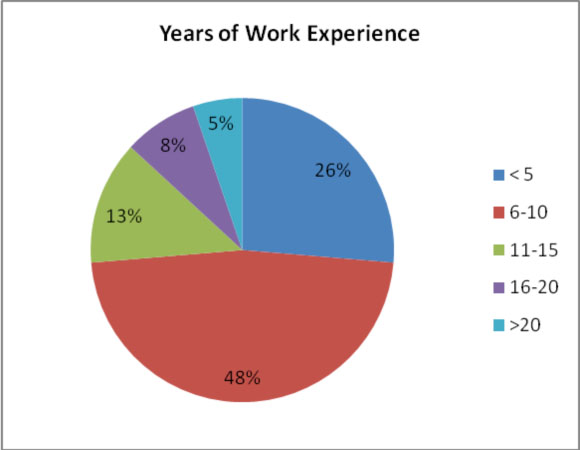 |
| Figure 3: Years of Professional Work Experience of Respondents. |
As observed from Figure 3, many (48%) of the librarians have between six and ten years of professional work experience, 26% percent have less than five years, 13% have between eleven and fifteen years, and 5% have more than twenty years work experience.
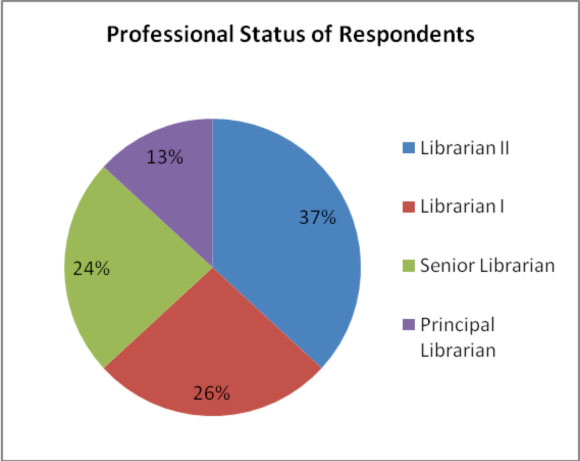 |
| Figure 4: Professional Status of Respondents. |
From Figure 4, 37% of the respondents are librarians II, 26% are librarians I, 24% are senior librarian, and 13% are principal librarian.
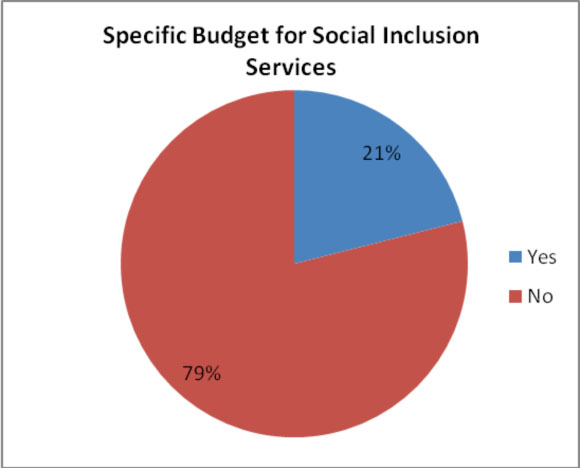 |
| Figure 5: Specific Budget for Social Inclusion Services. |
Figure 5 shows that 79% of the librarians reported that there is no specific budget for social inclusion services in their libraries. Generally, the library had a budget for their services but no specific percentage of it is set aside for social inclusion related information services. One of the ways to ensure commitment to a specific project is to have financial commitment for it. This will enable the library to channel its resources towards the execution of the project.
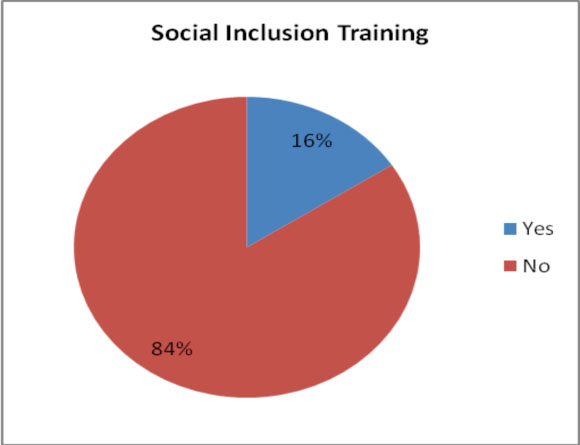 |
| Figure 6: Social Inclusion Training by Librarians. |
Eighty–four percent of the librarians as reported in Figure 6 have not had training on social inclusion related services. There is a need for specialized training for librarians to enable them to acquire the necessary knowledge and skills to render services that will enhance the living standard of the people. This has become necessary as the knowledge may not have been acquired from library school.
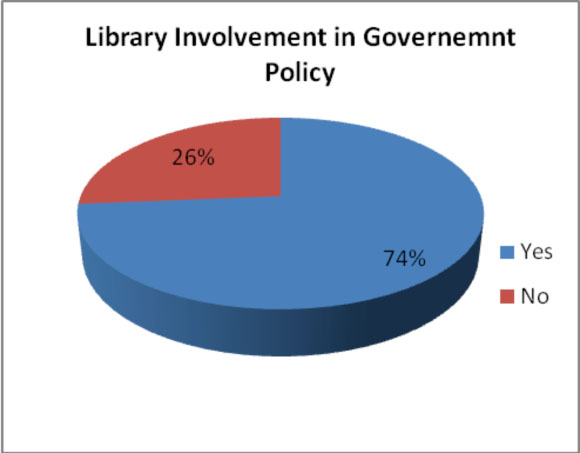 |
| Figure 7: Library Involvement in Government Policy Implementation. |
As observed in Figure 7, 74% of the public librarians responded that their libraries were involved in government policy implementation for uplifting people’s living conditions. But the areas of involvement include library renovation, funding, and ICT training. These are part of the responsibilities of government but working relationships between the various government agencies and the public libraries should also center on poverty alleviation, government policy information to the people, employment information, entrepreneurship development and training, etc.
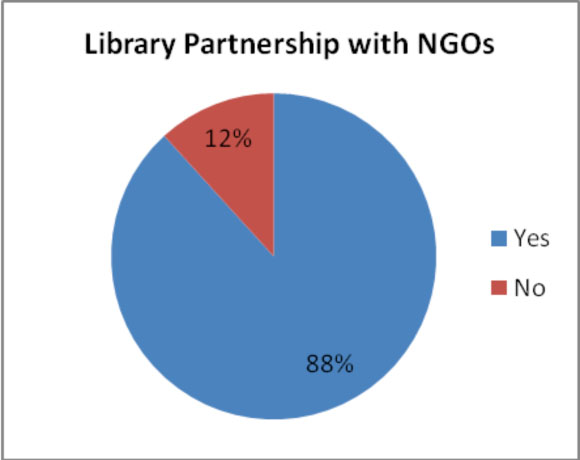 |
| Figure 8: Library Partnership with NGO. |
Figure 8 shows that 88% reported that their libraries are in one form of partnership or another with various organizations. The contribution of the NGOs includes funding, donation of library materials, and staff training. The libraries need to do more to attract organizations that may be interested in capacity building for the members of community, poverty alleviation, scholarship for indigent students, micro–credit loans for market men and women among others.
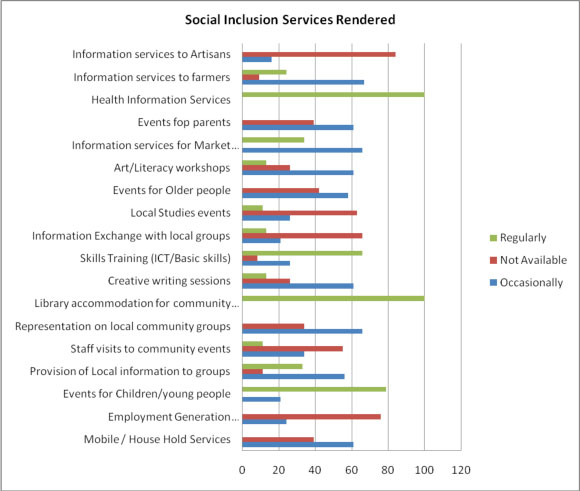 |
| Figure 9: Library Provision of Social Inclusion Related Services. |
It is obvious from Figure 9 that public libraries regularly render few services that may affect the socially excluded in their community. Seventy–nine percent render information services to children; 100% provide accommodation for community events; 66% ICT training; and 100% render health information services. There are more services that can promote social inclusion but are not being rendered regularly in the libraries. These include employment generation; poverty alleviation or empowerment workshops; and information services to farmers, market men and women, the elderly, artisans, etc. Information services to these categories of people are likely to bridge the gap between information haves and have–nots in the society. Farmers need regular information about the weather, improved farm seeds/seedlings, new farming techniques, etc. to boost their production. Adequate knowledge of government policies and programmes will promote the benefits derivable from it and better citizenry. Literacy programmes or creative writing sessions will help to reduce the level of illiteracy in the society and promote quality education, and citizens’ participation in government programmes.
4. Conclusion
Public libraries are established to service all segments of the society, particularly the ones that may not be able to afford the knowledge or the cost of accessing information from sophisticated information systems. It is a fact that many of the public libraries may not be able to render all information services required of them due to the numerous challenges they face. They should, within the limited resources available to them, prioritize and offer services that will affect the socially excluded people in the community. Librarians need to understand their community and serve their users’ needs for proper integration into the society.
5. Recommendations
Public librarians should be trained on rendering information services that will help promote inclusion in the society.
Adequate funds should be provided for public libraries to render services to all segments of the society, with priority on the socially excluded.
Public libraries should begin to carry out information need assessment of their community to have adequate knowledge of the various gaps in information services.
Public libraries should seek partnership with government and private organizations in the areas of capacity building, employment information and generation, investment opportunities, etc.
Public librarians should be well–educated and informed about government policies and programmes to enhance their knowledge and ability to guide the members of their respective communities.
Public libraries should be, more than ever before, ready to play a more educational role than the provision of books.
Relevant government agencies and NGOs should consider the public library when planning and implementing community based development.
Government and private organizations should share relevant demographic and development information with the public libraries to enhance the planning and implementing of information services programmes to their community.
References
Amonoo, P. and Azubuike, A. “Libraries and information society in Africa’ Geneva: Economic Commission for Africa, 2005 http://www.uneca.org/aisi/docs/PolicyBriefs/Libraries%20and%20the%20Information%20Society%20in%20Africa.pdf.
Bhalla, A. and Lapeyre, F. “Social exclusion: towards an analytical and operational framework’ Development and Change 28, 3 (2007): 413–433.
Muddiman, D. Open to all?: the public library and social exclusion, vol. 1: Overview and conclusions. London: Resource, 2000.
Dutch, M. and Muddiman, D. “The public library, social exclusion and the information society in the United Kingdom.” Libri, 51 (2001): 183–194.
EIFL. Public libraries play a vital role in community development. http://www.eifl.net/system/files/201109/plip_results_12_library_summary_hi.pdf.
Fourie, P. I. Public libraries addressing social inclusion: how we may think .... World Library and Information Congress: 73rd IFLA General Conference and Council, Durban, South Africa, 19–23 August, 2007. http://repository.up.ac.za/bitstream/handle/2263/3542/fourie_theoretical%282007%29.pdf?sequence=1.
Harande, Y. I. “Information Services for Rural community development in Nigeria” Library Philosophy and Practice (2009). http://www.webpages.uidaho.edu/~mbolin/harande.htm.
IFLA. The role of public libraries in lifelong learning: a project under the section of Public Libraries. IFLA, May, 2009.
Kabamba, J.M. “Libraries re–loaded in Service of the Marginalized.” IFLA Publications 134 (2008): 145–160.
Man, T. H. “Social inclusion and public libraries: Is the ability to empathise an essential attribute for community librarians to better serve their ethnic minority users? A case study of Highfield Library and its Chinese community.” Masters thesis, University of Sheffield, 2007. http://www.sheffield.ac.uk/polopoly_fs/1.128137!/file/Tso-Hin-Man.pdf.
Olanlokun, S. O. and Salisu, M. T. Understanding the library: a handbook on library use. Lagos: University Press, 1993.
Rubin, R. E. Foundations of library and information Science. 3rd ed. New York: Neal–Schuman Publishers, 2010.
Saliu, U. A. “The development and roles of public libraries in Nigeria.” Ilorin Journal of Education, 19 (1999). http://unilorin.edu.ng/journals/education/ije/june1999/THE%20DEVELOPMENT%20AND%20ROLES%20OF%20PUBLIC%20LIBRARIES%20IN%20NIGERIA.pdf.
Sheba, M. K. “Information for development in Africa.” Information Development, 4, no. 3, (September 1998): 152–154.
Tilly, C. “Poverty and the politics of exclusion” in Moving out of Poverty, eds. D. Narayan and P. Petesch. Washington, D.C.: World Bank, 2007.
UNESCO and IFLA UNESCO public library manifesto, 1994. http://www.unesco.org/webworld/libraries/manifestos/libraman.html.
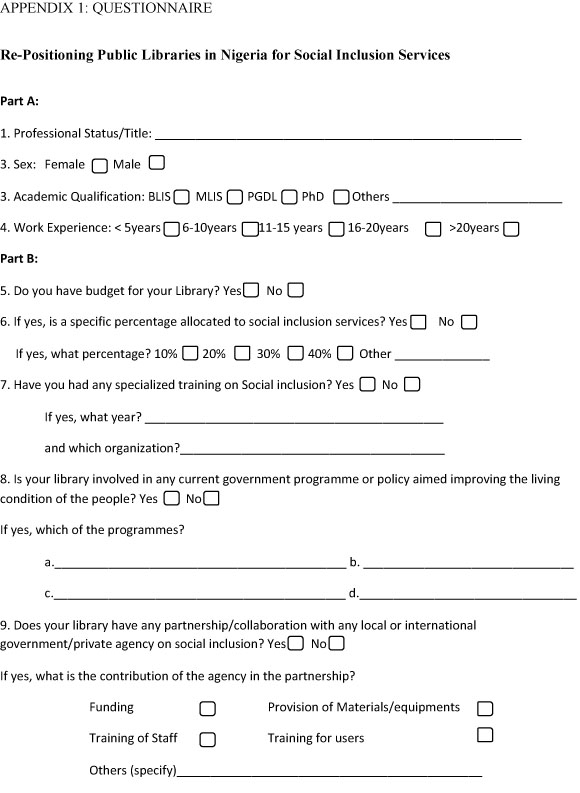 |
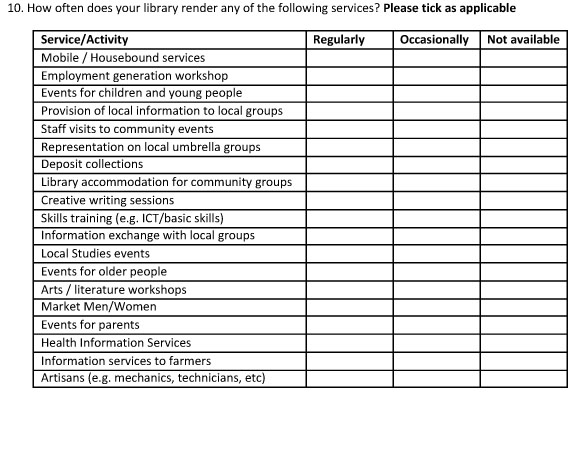 |
About the authors
Victor Esheruma Igiamoh is Librarian I and the head of the Online Resources/Help Desk Section of the Librarians’ Registration Council of Nigeria (LRCN). He has a bachelors degree in Library and Information Science (BLIS) and a masters degree in Information Science (MInfSc) from the University of Ibadan, Ibadan, Nigeria. He has about eight years of professional work experience in Nigeria.
Olubunmi Adesola Ogunwemimo works as Librarian I with the Oyo State Public Library, Ibadan, Nigeria. She has a bachelors degree in Library and Information Science and a masters degree in Information Science (MInfSc) from the University of Ibadan, Ibadan, Nigeria. She has about nine years of professional work experience in public librarianship in Nigeria.
© 2013 Victor Esheruma Igiamoh and Olubunmi Adesola Ogunwemimo.